Health and Well-being: Social Inequalities in Health, Analysis Report
VerifiedAdded on 2021/12/10
|13
|5288
|132
Report
AI Summary
This report examines the intricate relationship between health and well-being and the pervasive influence of social inequalities. It explores the disparities in health outcomes linked to socioeconomic factors, age, and sex, with a specific focus on the challenges faced by adults with learning disabilities. The report delves into the impact of poverty, unemployment, and inadequate housing on health, alongside the role of lifestyle factors like smoking, alcohol consumption, and poor diet. The life course perspective is employed to understand how early-life experiences and major life transitions shape health trajectories. Furthermore, the report addresses the concepts of well-being, stigma, and discrimination, highlighting their effects on mental health and overall quality of life. The analysis underscores the need for social workers and healthcare providers to address these complex issues to promote health equity and improve the well-being of vulnerable populations. This report aims to provide a comprehensive understanding of the social determinants of health and their impact on individuals and communities.
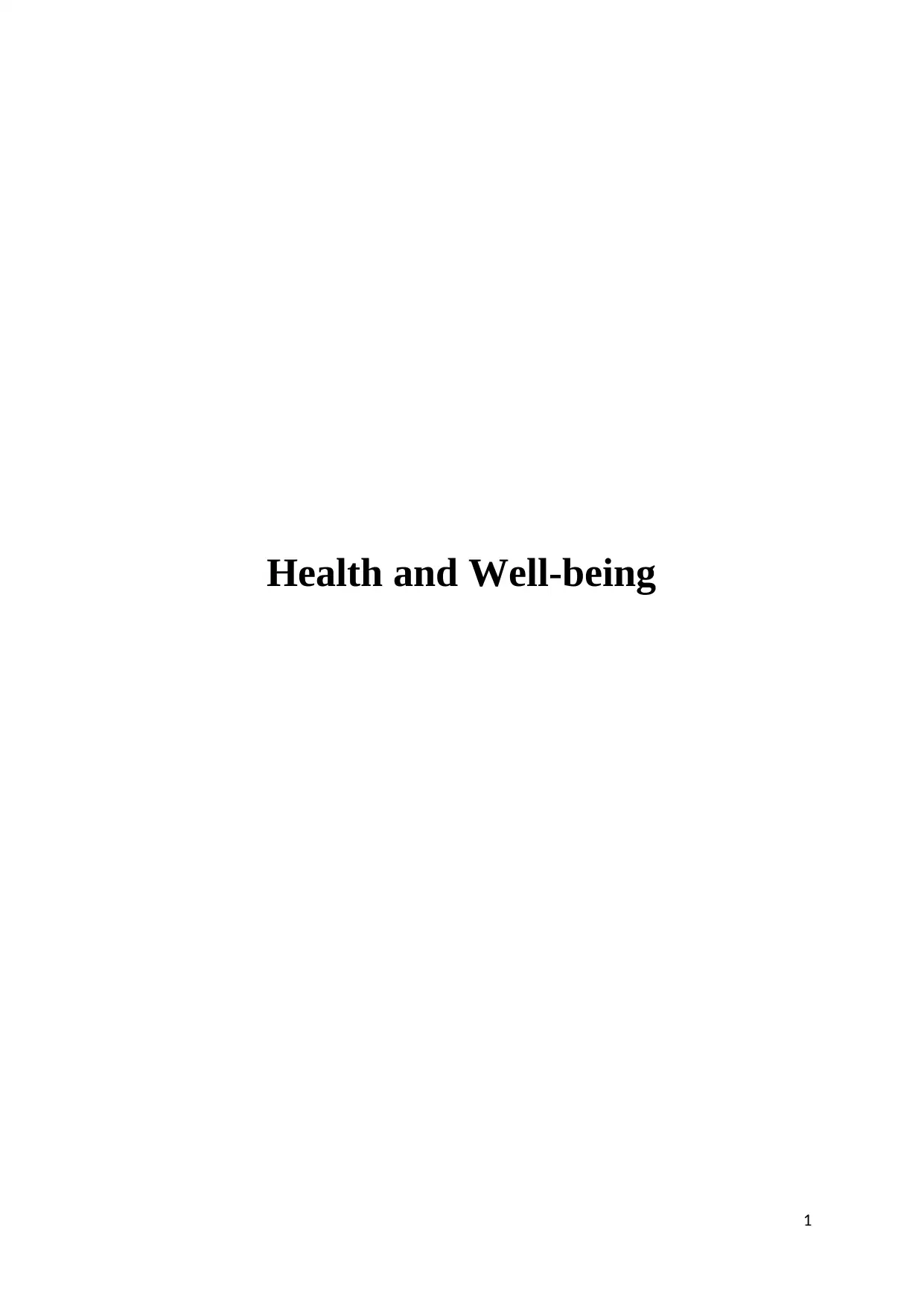
Health and Well-being
1
1
Paraphrase This Document
Need a fresh take? Get an instant paraphrase of this document with our AI Paraphraser
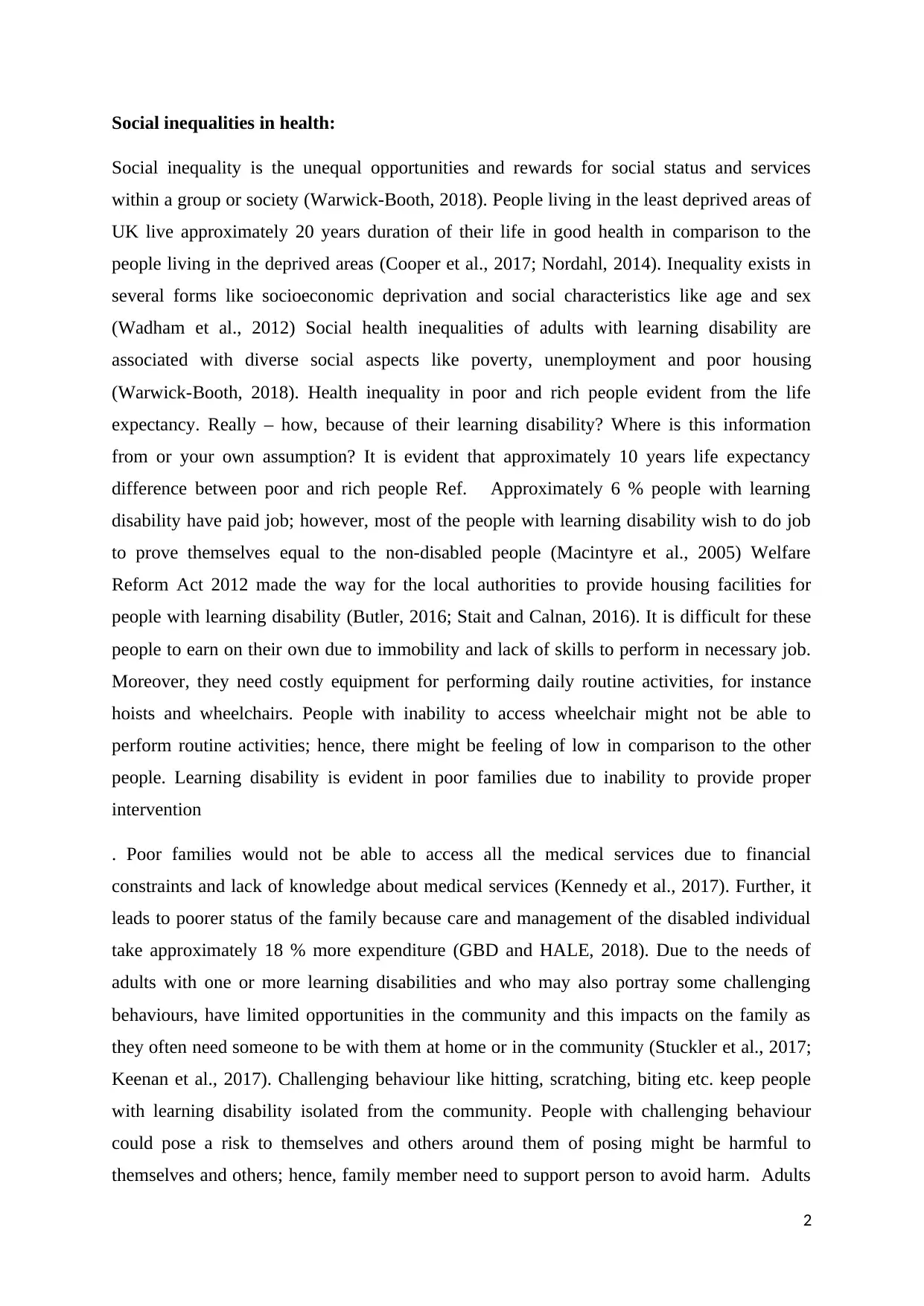
Social inequalities in health:
Social inequality is the unequal opportunities and rewards for social status and services
within a group or society (Warwick-Booth, 2018). People living in the least deprived areas of
UK live approximately 20 years duration of their life in good health in comparison to the
people living in the deprived areas (Cooper et al., 2017; Nordahl, 2014). Inequality exists in
several forms like socioeconomic deprivation and social characteristics like age and sex
(Wadham et al., 2012) Social health inequalities of adults with learning disability are
associated with diverse social aspects like poverty, unemployment and poor housing
(Warwick-Booth, 2018). Health inequality in poor and rich people evident from the life
expectancy. Really – how, because of their learning disability? Where is this information
from or your own assumption? It is evident that approximately 10 years life expectancy
difference between poor and rich people Ref. Approximately 6 % people with learning
disability have paid job; however, most of the people with learning disability wish to do job
to prove themselves equal to the non-disabled people (Macintyre et al., 2005) Welfare
Reform Act 2012 made the way for the local authorities to provide housing facilities for
people with learning disability (Butler, 2016; Stait and Calnan, 2016). It is difficult for these
people to earn on their own due to immobility and lack of skills to perform in necessary job.
Moreover, they need costly equipment for performing daily routine activities, for instance
hoists and wheelchairs. People with inability to access wheelchair might not be able to
perform routine activities; hence, there might be feeling of low in comparison to the other
people. Learning disability is evident in poor families due to inability to provide proper
intervention
. Poor families would not be able to access all the medical services due to financial
constraints and lack of knowledge about medical services (Kennedy et al., 2017). Further, it
leads to poorer status of the family because care and management of the disabled individual
take approximately 18 % more expenditure (GBD and HALE, 2018). Due to the needs of
adults with one or more learning disabilities and who may also portray some challenging
behaviours, have limited opportunities in the community and this impacts on the family as
they often need someone to be with them at home or in the community (Stuckler et al., 2017;
Keenan et al., 2017). Challenging behaviour like hitting, scratching, biting etc. keep people
with learning disability isolated from the community. People with challenging behaviour
could pose a risk to themselves and others around them of posing might be harmful to
themselves and others; hence, family member need to support person to avoid harm. Adults
2
Social inequality is the unequal opportunities and rewards for social status and services
within a group or society (Warwick-Booth, 2018). People living in the least deprived areas of
UK live approximately 20 years duration of their life in good health in comparison to the
people living in the deprived areas (Cooper et al., 2017; Nordahl, 2014). Inequality exists in
several forms like socioeconomic deprivation and social characteristics like age and sex
(Wadham et al., 2012) Social health inequalities of adults with learning disability are
associated with diverse social aspects like poverty, unemployment and poor housing
(Warwick-Booth, 2018). Health inequality in poor and rich people evident from the life
expectancy. Really – how, because of their learning disability? Where is this information
from or your own assumption? It is evident that approximately 10 years life expectancy
difference between poor and rich people Ref. Approximately 6 % people with learning
disability have paid job; however, most of the people with learning disability wish to do job
to prove themselves equal to the non-disabled people (Macintyre et al., 2005) Welfare
Reform Act 2012 made the way for the local authorities to provide housing facilities for
people with learning disability (Butler, 2016; Stait and Calnan, 2016). It is difficult for these
people to earn on their own due to immobility and lack of skills to perform in necessary job.
Moreover, they need costly equipment for performing daily routine activities, for instance
hoists and wheelchairs. People with inability to access wheelchair might not be able to
perform routine activities; hence, there might be feeling of low in comparison to the other
people. Learning disability is evident in poor families due to inability to provide proper
intervention
. Poor families would not be able to access all the medical services due to financial
constraints and lack of knowledge about medical services (Kennedy et al., 2017). Further, it
leads to poorer status of the family because care and management of the disabled individual
take approximately 18 % more expenditure (GBD and HALE, 2018). Due to the needs of
adults with one or more learning disabilities and who may also portray some challenging
behaviours, have limited opportunities in the community and this impacts on the family as
they often need someone to be with them at home or in the community (Stuckler et al., 2017;
Keenan et al., 2017). Challenging behaviour like hitting, scratching, biting etc. keep people
with learning disability isolated from the community. People with challenging behaviour
could pose a risk to themselves and others around them of posing might be harmful to
themselves and others; hence, family member need to support person to avoid harm. Adults
2

with learning disability are always homebound; hence, other person of the family need to stay
at home to take care of the homebound disabled person. Henceforth, another person of the
family also cannot earn the money. Overall total income of the family badly affected due to
adult with learning disability. Family person accompanying person with challenging
behaviour would not be able to do job; hence, it can produce financial burden on the family
(Evandrou et al., 2016).
According to Health Survey of England, 2016; mainly four unhealthy lifestyle behaviours
like smoking, excessive alcohol consumption, poor diet and lack of exercise and poor diet are
responsible for health inequalities (HSE, 2017) Smoking and alcohol lead to development of
different chronic diseases. It impacts health of the person; also, it impacts financial aspect
because person with disease need to spend more amount of money for the treatment and
management of the disease. Poor diet and lack of exercise lead to improper maintenance of
health. (Buck and Frosini, 2012).
The Life Course:
Life course is paradigm to study people’s lives, structural contexts and social change. Life
course perspective of the person varies based on the social, financial, epidemiological and
psychological aspects. Positive social context produces favourable impact on the life course
of the person. Sound financial condition can produce healthy life course. Person need to be
psychologically positive to shape life course to adapt the changing social scenarios (Burton-
Jeangros, 2015). Social issues in the childhood are responsible for the alteration in the
biological development. Social environment and social relationship are mainly responsible
for the physical and cognitive development. Children in the poor socioeconomic class might
encounter eating disorders, lack of immunization and sporting inability. It would lead to
improper physical and psychological development of the child (Kolb, 2014). Low
socioeconomic status might lead to disturbance in the biological development. It is essential
to consider the life events where biological alterations; which, lead to health inequalities.
Different stressful life events like daily hassles, work overload and financial difficulties
might lead to both physical and psychological disorders. Social worker needs to consider
complete history of the service users to understand serious illness of the service users. Social
determinants of health like occupational status, economic status, housing environment and
family circumstances affects health status of the person differently at different age of the
person (Runyan, 2018). Needs of the people are different at different life stage; hence,
3
at home to take care of the homebound disabled person. Henceforth, another person of the
family also cannot earn the money. Overall total income of the family badly affected due to
adult with learning disability. Family person accompanying person with challenging
behaviour would not be able to do job; hence, it can produce financial burden on the family
(Evandrou et al., 2016).
According to Health Survey of England, 2016; mainly four unhealthy lifestyle behaviours
like smoking, excessive alcohol consumption, poor diet and lack of exercise and poor diet are
responsible for health inequalities (HSE, 2017) Smoking and alcohol lead to development of
different chronic diseases. It impacts health of the person; also, it impacts financial aspect
because person with disease need to spend more amount of money for the treatment and
management of the disease. Poor diet and lack of exercise lead to improper maintenance of
health. (Buck and Frosini, 2012).
The Life Course:
Life course is paradigm to study people’s lives, structural contexts and social change. Life
course perspective of the person varies based on the social, financial, epidemiological and
psychological aspects. Positive social context produces favourable impact on the life course
of the person. Sound financial condition can produce healthy life course. Person need to be
psychologically positive to shape life course to adapt the changing social scenarios (Burton-
Jeangros, 2015). Social issues in the childhood are responsible for the alteration in the
biological development. Social environment and social relationship are mainly responsible
for the physical and cognitive development. Children in the poor socioeconomic class might
encounter eating disorders, lack of immunization and sporting inability. It would lead to
improper physical and psychological development of the child (Kolb, 2014). Low
socioeconomic status might lead to disturbance in the biological development. It is essential
to consider the life events where biological alterations; which, lead to health inequalities.
Different stressful life events like daily hassles, work overload and financial difficulties
might lead to both physical and psychological disorders. Social worker needs to consider
complete history of the service users to understand serious illness of the service users. Social
determinants of health like occupational status, economic status, housing environment and
family circumstances affects health status of the person differently at different age of the
person (Runyan, 2018). Needs of the people are different at different life stage; hence,
3
⊘ This is a preview!⊘
Do you want full access?
Subscribe today to unlock all pages.

Trusted by 1+ million students worldwide
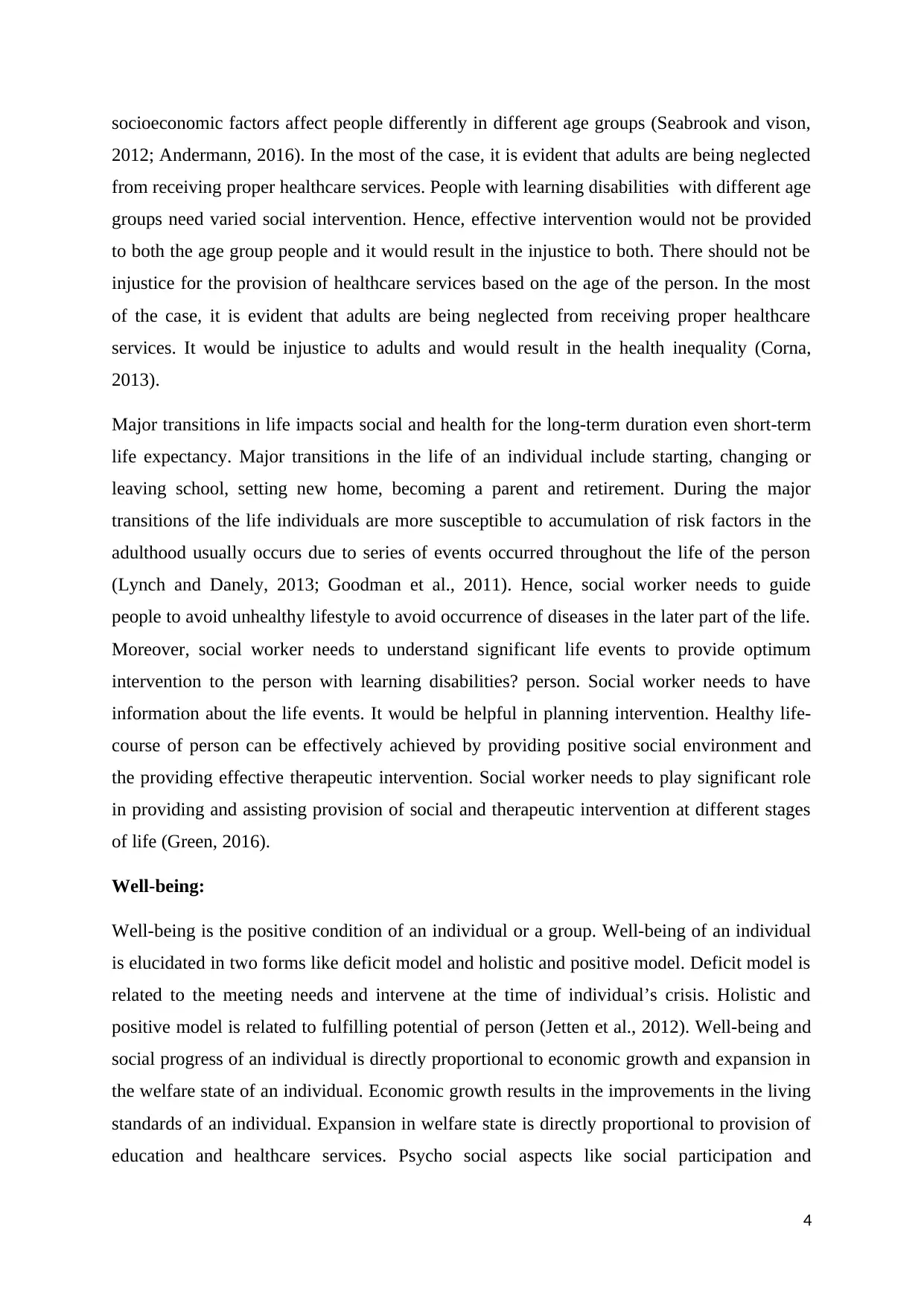
socioeconomic factors affect people differently in different age groups (Seabrook and vison,
2012; Andermann, 2016). In the most of the case, it is evident that adults are being neglected
from receiving proper healthcare services. People with learning disabilities with different age
groups need varied social intervention. Hence, effective intervention would not be provided
to both the age group people and it would result in the injustice to both. There should not be
injustice for the provision of healthcare services based on the age of the person. In the most
of the case, it is evident that adults are being neglected from receiving proper healthcare
services. It would be injustice to adults and would result in the health inequality (Corna,
2013).
Major transitions in life impacts social and health for the long-term duration even short-term
life expectancy. Major transitions in the life of an individual include starting, changing or
leaving school, setting new home, becoming a parent and retirement. During the major
transitions of the life individuals are more susceptible to accumulation of risk factors in the
adulthood usually occurs due to series of events occurred throughout the life of the person
(Lynch and Danely, 2013; Goodman et al., 2011). Hence, social worker needs to guide
people to avoid unhealthy lifestyle to avoid occurrence of diseases in the later part of the life.
Moreover, social worker needs to understand significant life events to provide optimum
intervention to the person with learning disabilities? person. Social worker needs to have
information about the life events. It would be helpful in planning intervention. Healthy life-
course of person can be effectively achieved by providing positive social environment and
the providing effective therapeutic intervention. Social worker needs to play significant role
in providing and assisting provision of social and therapeutic intervention at different stages
of life (Green, 2016).
Well-being:
Well-being is the positive condition of an individual or a group. Well-being of an individual
is elucidated in two forms like deficit model and holistic and positive model. Deficit model is
related to the meeting needs and intervene at the time of individual’s crisis. Holistic and
positive model is related to fulfilling potential of person (Jetten et al., 2012). Well-being and
social progress of an individual is directly proportional to economic growth and expansion in
the welfare state of an individual. Economic growth results in the improvements in the living
standards of an individual. Expansion in welfare state is directly proportional to provision of
education and healthcare services. Psycho social aspects like social participation and
4
2012; Andermann, 2016). In the most of the case, it is evident that adults are being neglected
from receiving proper healthcare services. People with learning disabilities with different age
groups need varied social intervention. Hence, effective intervention would not be provided
to both the age group people and it would result in the injustice to both. There should not be
injustice for the provision of healthcare services based on the age of the person. In the most
of the case, it is evident that adults are being neglected from receiving proper healthcare
services. It would be injustice to adults and would result in the health inequality (Corna,
2013).
Major transitions in life impacts social and health for the long-term duration even short-term
life expectancy. Major transitions in the life of an individual include starting, changing or
leaving school, setting new home, becoming a parent and retirement. During the major
transitions of the life individuals are more susceptible to accumulation of risk factors in the
adulthood usually occurs due to series of events occurred throughout the life of the person
(Lynch and Danely, 2013; Goodman et al., 2011). Hence, social worker needs to guide
people to avoid unhealthy lifestyle to avoid occurrence of diseases in the later part of the life.
Moreover, social worker needs to understand significant life events to provide optimum
intervention to the person with learning disabilities? person. Social worker needs to have
information about the life events. It would be helpful in planning intervention. Healthy life-
course of person can be effectively achieved by providing positive social environment and
the providing effective therapeutic intervention. Social worker needs to play significant role
in providing and assisting provision of social and therapeutic intervention at different stages
of life (Green, 2016).
Well-being:
Well-being is the positive condition of an individual or a group. Well-being of an individual
is elucidated in two forms like deficit model and holistic and positive model. Deficit model is
related to the meeting needs and intervene at the time of individual’s crisis. Holistic and
positive model is related to fulfilling potential of person (Jetten et al., 2012). Well-being and
social progress of an individual is directly proportional to economic growth and expansion in
the welfare state of an individual. Economic growth results in the improvements in the living
standards of an individual. Expansion in welfare state is directly proportional to provision of
education and healthcare services. Psycho social aspects like social participation and
4
Paraphrase This Document
Need a fresh take? Get an instant paraphrase of this document with our AI Paraphraser

autonomy affects well-being of an individual. Social participation and autonomy are
interrelated because autonomy results in the reduced social participation (Huppert et al.,
2005). Poverty, un-educated status, low socioeconomic status and inequality of an individual
are related to both social participation and autonomy because these individuals consider them
excluded from the society or society keep them isolated from the mainstream society. Social
well-being of an individual is important factor for the well-being of an individual. Social-well
being of an individual mainly depends on his/her social exposure. Different levels of social
exposure are varied at different stages of life and at different life events. Complexity and
diversity of the social exposure affects social well-being of an individual. Health inequality is
an indicator of the social well-being. Rate of morbidity and mortality are the measurement
parameters of the health inequality (Haworth and Hart, 2007).
Factors like poverty, education and social exclusion are mainly responsible for the health
inequality and deprived social well-being. Hence, health inequality affects well-being of an
individual. Poor mental health is a significant public and social health challenge because
individuals with mental health challenge would not be able to care of their health. Hence,
mental health issues are significantly associated with the health and social inequalities. Social
inequality has strong influence on the mental health of an individual because deprived people
are mostly associated with the poor mental health. Moreover, people with mental health
issues are not willing to approach healthcare providers which lead to negative impact on the
health outcome. Physical and mental health are associated with the worklessness, loss due to
unpaid work and sickness absence (Palmer et al., 2013). Life course also impacts mental
illness. People in UK, in the age group 16 – 24 yrs are more susceptible to mental health
problems and self-harm. Half of the mental illness conditions occur in mid-teens and three-
quarters occur in mid-20s. Mental health issue in this is a social issue because it can lead to
learning disability in the future (Cowlishaw and Kessler, 2016). Occurrence of mental health
issues in these age group people are influenced by social exposure in the early age. Adverse
childhood, abuse and neglect, poor parenting and parental mental health problems in the
childhood affect later stage mental health condition. Disturbance in the mental health
condition might lead to learning disability (Friedli, 2009; Marmot et al., 2010).
Stigma and discrimination:
Learning disability is also referred as specific learning disorder. It is a neurological disorder
which mainly affects information processing. It impacts how person learns, understands,
5
interrelated because autonomy results in the reduced social participation (Huppert et al.,
2005). Poverty, un-educated status, low socioeconomic status and inequality of an individual
are related to both social participation and autonomy because these individuals consider them
excluded from the society or society keep them isolated from the mainstream society. Social
well-being of an individual is important factor for the well-being of an individual. Social-well
being of an individual mainly depends on his/her social exposure. Different levels of social
exposure are varied at different stages of life and at different life events. Complexity and
diversity of the social exposure affects social well-being of an individual. Health inequality is
an indicator of the social well-being. Rate of morbidity and mortality are the measurement
parameters of the health inequality (Haworth and Hart, 2007).
Factors like poverty, education and social exclusion are mainly responsible for the health
inequality and deprived social well-being. Hence, health inequality affects well-being of an
individual. Poor mental health is a significant public and social health challenge because
individuals with mental health challenge would not be able to care of their health. Hence,
mental health issues are significantly associated with the health and social inequalities. Social
inequality has strong influence on the mental health of an individual because deprived people
are mostly associated with the poor mental health. Moreover, people with mental health
issues are not willing to approach healthcare providers which lead to negative impact on the
health outcome. Physical and mental health are associated with the worklessness, loss due to
unpaid work and sickness absence (Palmer et al., 2013). Life course also impacts mental
illness. People in UK, in the age group 16 – 24 yrs are more susceptible to mental health
problems and self-harm. Half of the mental illness conditions occur in mid-teens and three-
quarters occur in mid-20s. Mental health issue in this is a social issue because it can lead to
learning disability in the future (Cowlishaw and Kessler, 2016). Occurrence of mental health
issues in these age group people are influenced by social exposure in the early age. Adverse
childhood, abuse and neglect, poor parenting and parental mental health problems in the
childhood affect later stage mental health condition. Disturbance in the mental health
condition might lead to learning disability (Friedli, 2009; Marmot et al., 2010).
Stigma and discrimination:
Learning disability is also referred as specific learning disorder. It is a neurological disorder
which mainly affects information processing. It impacts how person learns, understands,
5
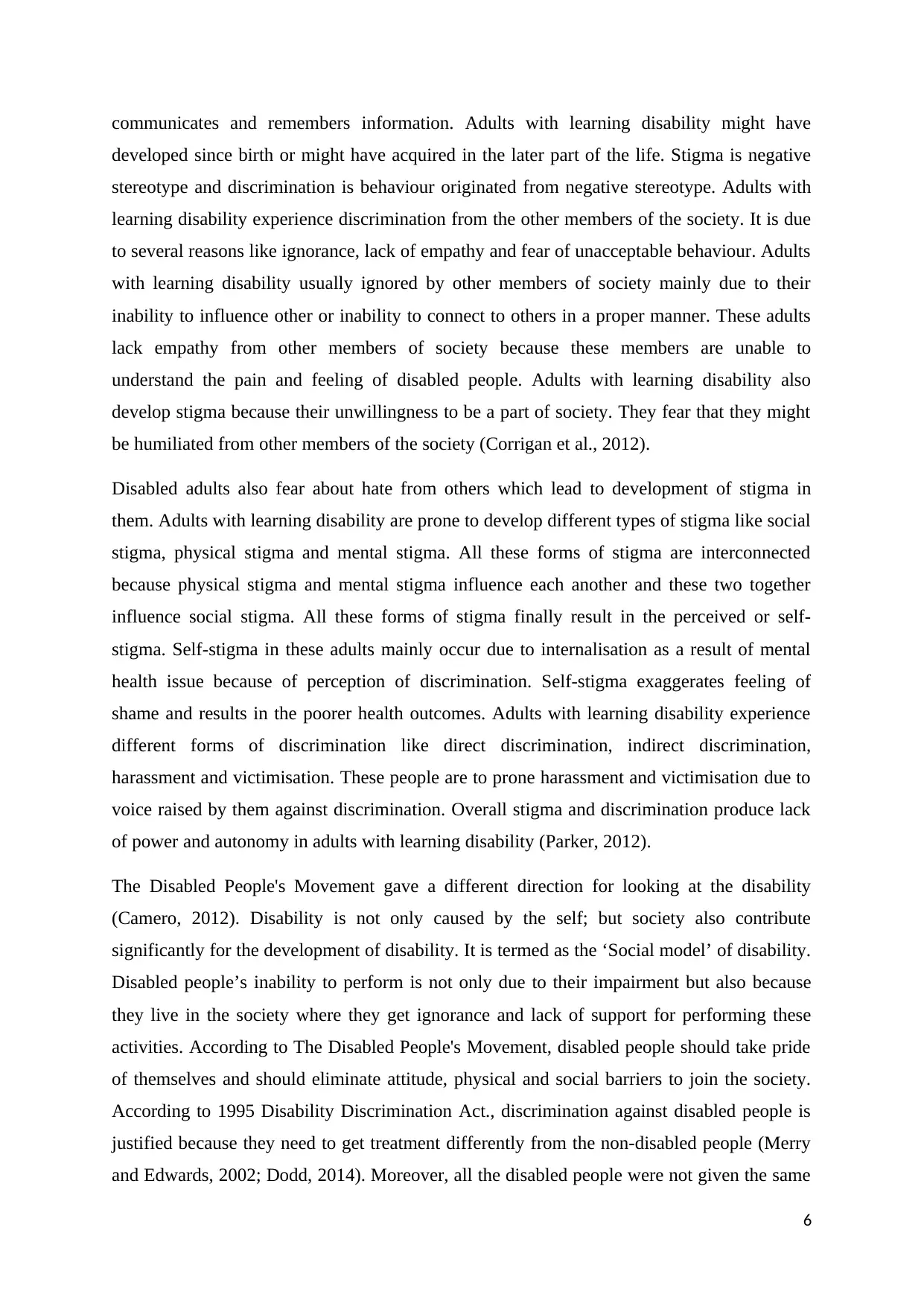
communicates and remembers information. Adults with learning disability might have
developed since birth or might have acquired in the later part of the life. Stigma is negative
stereotype and discrimination is behaviour originated from negative stereotype. Adults with
learning disability experience discrimination from the other members of the society. It is due
to several reasons like ignorance, lack of empathy and fear of unacceptable behaviour. Adults
with learning disability usually ignored by other members of society mainly due to their
inability to influence other or inability to connect to others in a proper manner. These adults
lack empathy from other members of society because these members are unable to
understand the pain and feeling of disabled people. Adults with learning disability also
develop stigma because their unwillingness to be a part of society. They fear that they might
be humiliated from other members of the society (Corrigan et al., 2012).
Disabled adults also fear about hate from others which lead to development of stigma in
them. Adults with learning disability are prone to develop different types of stigma like social
stigma, physical stigma and mental stigma. All these forms of stigma are interconnected
because physical stigma and mental stigma influence each another and these two together
influence social stigma. All these forms of stigma finally result in the perceived or self-
stigma. Self-stigma in these adults mainly occur due to internalisation as a result of mental
health issue because of perception of discrimination. Self-stigma exaggerates feeling of
shame and results in the poorer health outcomes. Adults with learning disability experience
different forms of discrimination like direct discrimination, indirect discrimination,
harassment and victimisation. These people are to prone harassment and victimisation due to
voice raised by them against discrimination. Overall stigma and discrimination produce lack
of power and autonomy in adults with learning disability (Parker, 2012).
The Disabled People's Movement gave a different direction for looking at the disability
(Camero, 2012). Disability is not only caused by the self; but society also contribute
significantly for the development of disability. It is termed as the ‘Social model’ of disability.
Disabled people’s inability to perform is not only due to their impairment but also because
they live in the society where they get ignorance and lack of support for performing these
activities. According to The Disabled People's Movement, disabled people should take pride
of themselves and should eliminate attitude, physical and social barriers to join the society.
According to 1995 Disability Discrimination Act., discrimination against disabled people is
justified because they need to get treatment differently from the non-disabled people (Merry
and Edwards, 2002; Dodd, 2014). Moreover, all the disabled people were not given the same
6
developed since birth or might have acquired in the later part of the life. Stigma is negative
stereotype and discrimination is behaviour originated from negative stereotype. Adults with
learning disability experience discrimination from the other members of the society. It is due
to several reasons like ignorance, lack of empathy and fear of unacceptable behaviour. Adults
with learning disability usually ignored by other members of society mainly due to their
inability to influence other or inability to connect to others in a proper manner. These adults
lack empathy from other members of society because these members are unable to
understand the pain and feeling of disabled people. Adults with learning disability also
develop stigma because their unwillingness to be a part of society. They fear that they might
be humiliated from other members of the society (Corrigan et al., 2012).
Disabled adults also fear about hate from others which lead to development of stigma in
them. Adults with learning disability are prone to develop different types of stigma like social
stigma, physical stigma and mental stigma. All these forms of stigma are interconnected
because physical stigma and mental stigma influence each another and these two together
influence social stigma. All these forms of stigma finally result in the perceived or self-
stigma. Self-stigma in these adults mainly occur due to internalisation as a result of mental
health issue because of perception of discrimination. Self-stigma exaggerates feeling of
shame and results in the poorer health outcomes. Adults with learning disability experience
different forms of discrimination like direct discrimination, indirect discrimination,
harassment and victimisation. These people are to prone harassment and victimisation due to
voice raised by them against discrimination. Overall stigma and discrimination produce lack
of power and autonomy in adults with learning disability (Parker, 2012).
The Disabled People's Movement gave a different direction for looking at the disability
(Camero, 2012). Disability is not only caused by the self; but society also contribute
significantly for the development of disability. It is termed as the ‘Social model’ of disability.
Disabled people’s inability to perform is not only due to their impairment but also because
they live in the society where they get ignorance and lack of support for performing these
activities. According to The Disabled People's Movement, disabled people should take pride
of themselves and should eliminate attitude, physical and social barriers to join the society.
According to 1995 Disability Discrimination Act., discrimination against disabled people is
justified because they need to get treatment differently from the non-disabled people (Merry
and Edwards, 2002; Dodd, 2014). Moreover, all the disabled people were not given the same
6
⊘ This is a preview!⊘
Do you want full access?
Subscribe today to unlock all pages.

Trusted by 1+ million students worldwide
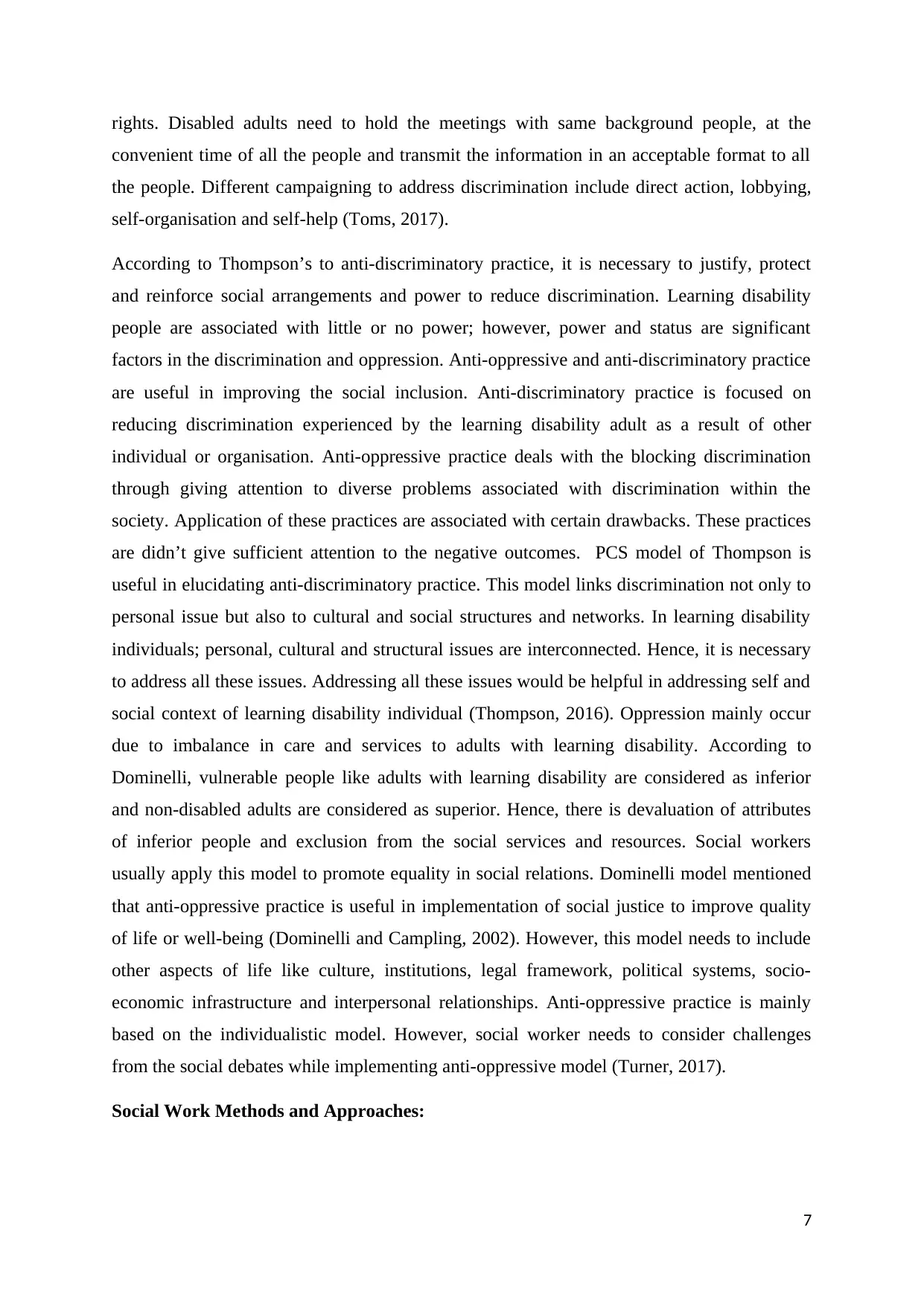
rights. Disabled adults need to hold the meetings with same background people, at the
convenient time of all the people and transmit the information in an acceptable format to all
the people. Different campaigning to address discrimination include direct action, lobbying,
self-organisation and self-help (Toms, 2017).
According to Thompson’s to anti-discriminatory practice, it is necessary to justify, protect
and reinforce social arrangements and power to reduce discrimination. Learning disability
people are associated with little or no power; however, power and status are significant
factors in the discrimination and oppression. Anti-oppressive and anti-discriminatory practice
are useful in improving the social inclusion. Anti-discriminatory practice is focused on
reducing discrimination experienced by the learning disability adult as a result of other
individual or organisation. Anti-oppressive practice deals with the blocking discrimination
through giving attention to diverse problems associated with discrimination within the
society. Application of these practices are associated with certain drawbacks. These practices
are didn’t give sufficient attention to the negative outcomes. PCS model of Thompson is
useful in elucidating anti-discriminatory practice. This model links discrimination not only to
personal issue but also to cultural and social structures and networks. In learning disability
individuals; personal, cultural and structural issues are interconnected. Hence, it is necessary
to address all these issues. Addressing all these issues would be helpful in addressing self and
social context of learning disability individual (Thompson, 2016). Oppression mainly occur
due to imbalance in care and services to adults with learning disability. According to
Dominelli, vulnerable people like adults with learning disability are considered as inferior
and non-disabled adults are considered as superior. Hence, there is devaluation of attributes
of inferior people and exclusion from the social services and resources. Social workers
usually apply this model to promote equality in social relations. Dominelli model mentioned
that anti-oppressive practice is useful in implementation of social justice to improve quality
of life or well-being (Dominelli and Campling, 2002). However, this model needs to include
other aspects of life like culture, institutions, legal framework, political systems, socio-
economic infrastructure and interpersonal relationships. Anti-oppressive practice is mainly
based on the individualistic model. However, social worker needs to consider challenges
from the social debates while implementing anti-oppressive model (Turner, 2017).
Social Work Methods and Approaches:
7
convenient time of all the people and transmit the information in an acceptable format to all
the people. Different campaigning to address discrimination include direct action, lobbying,
self-organisation and self-help (Toms, 2017).
According to Thompson’s to anti-discriminatory practice, it is necessary to justify, protect
and reinforce social arrangements and power to reduce discrimination. Learning disability
people are associated with little or no power; however, power and status are significant
factors in the discrimination and oppression. Anti-oppressive and anti-discriminatory practice
are useful in improving the social inclusion. Anti-discriminatory practice is focused on
reducing discrimination experienced by the learning disability adult as a result of other
individual or organisation. Anti-oppressive practice deals with the blocking discrimination
through giving attention to diverse problems associated with discrimination within the
society. Application of these practices are associated with certain drawbacks. These practices
are didn’t give sufficient attention to the negative outcomes. PCS model of Thompson is
useful in elucidating anti-discriminatory practice. This model links discrimination not only to
personal issue but also to cultural and social structures and networks. In learning disability
individuals; personal, cultural and structural issues are interconnected. Hence, it is necessary
to address all these issues. Addressing all these issues would be helpful in addressing self and
social context of learning disability individual (Thompson, 2016). Oppression mainly occur
due to imbalance in care and services to adults with learning disability. According to
Dominelli, vulnerable people like adults with learning disability are considered as inferior
and non-disabled adults are considered as superior. Hence, there is devaluation of attributes
of inferior people and exclusion from the social services and resources. Social workers
usually apply this model to promote equality in social relations. Dominelli model mentioned
that anti-oppressive practice is useful in implementation of social justice to improve quality
of life or well-being (Dominelli and Campling, 2002). However, this model needs to include
other aspects of life like culture, institutions, legal framework, political systems, socio-
economic infrastructure and interpersonal relationships. Anti-oppressive practice is mainly
based on the individualistic model. However, social worker needs to consider challenges
from the social debates while implementing anti-oppressive model (Turner, 2017).
Social Work Methods and Approaches:
7
Paraphrase This Document
Need a fresh take? Get an instant paraphrase of this document with our AI Paraphraser
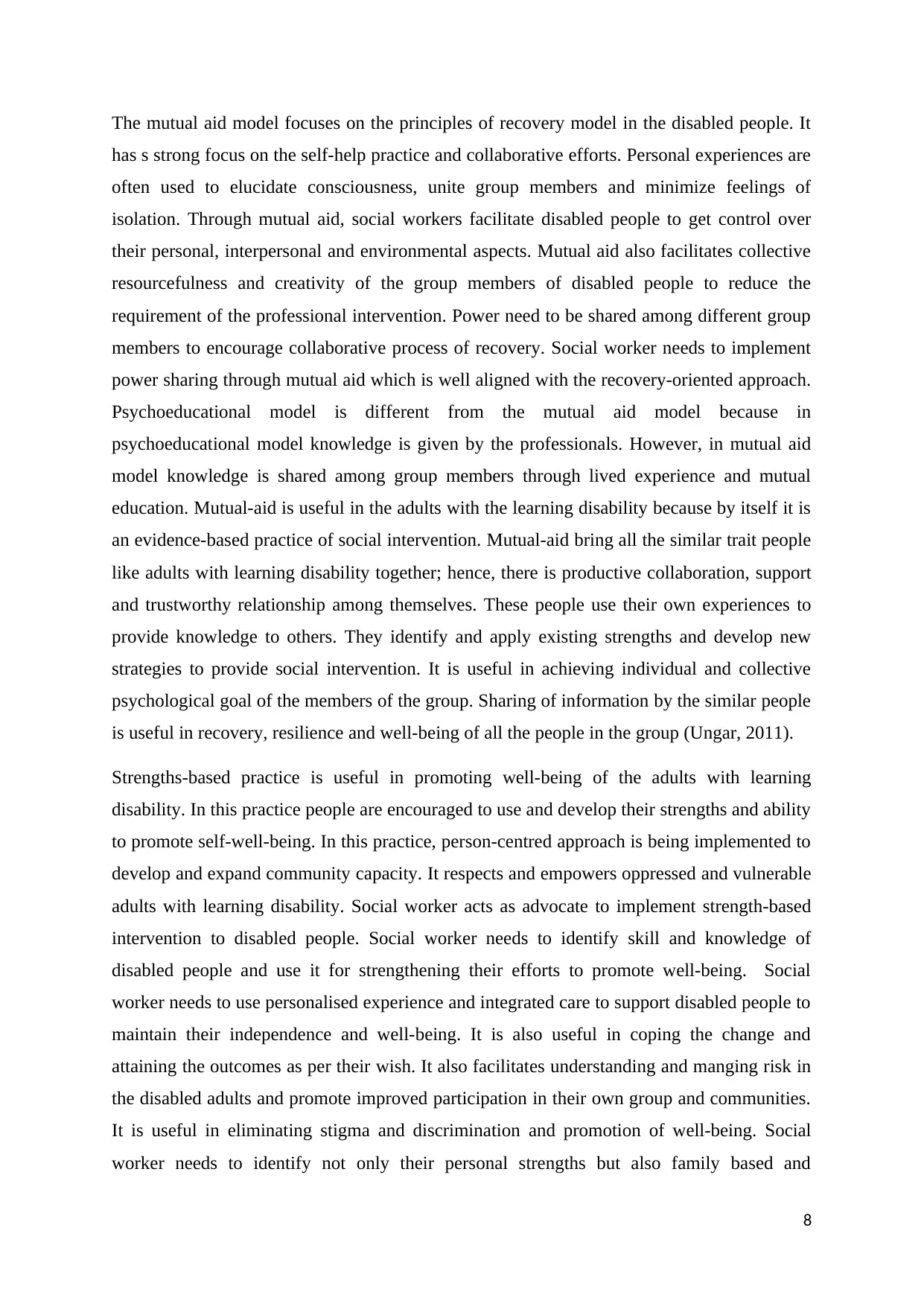
The mutual aid model focuses on the principles of recovery model in the disabled people. It
has s strong focus on the self-help practice and collaborative efforts. Personal experiences are
often used to elucidate consciousness, unite group members and minimize feelings of
isolation. Through mutual aid, social workers facilitate disabled people to get control over
their personal, interpersonal and environmental aspects. Mutual aid also facilitates collective
resourcefulness and creativity of the group members of disabled people to reduce the
requirement of the professional intervention. Power need to be shared among different group
members to encourage collaborative process of recovery. Social worker needs to implement
power sharing through mutual aid which is well aligned with the recovery-oriented approach.
Psychoeducational model is different from the mutual aid model because in
psychoeducational model knowledge is given by the professionals. However, in mutual aid
model knowledge is shared among group members through lived experience and mutual
education. Mutual-aid is useful in the adults with the learning disability because by itself it is
an evidence-based practice of social intervention. Mutual-aid bring all the similar trait people
like adults with learning disability together; hence, there is productive collaboration, support
and trustworthy relationship among themselves. These people use their own experiences to
provide knowledge to others. They identify and apply existing strengths and develop new
strategies to provide social intervention. It is useful in achieving individual and collective
psychological goal of the members of the group. Sharing of information by the similar people
is useful in recovery, resilience and well-being of all the people in the group (Ungar, 2011).
Strengths-based practice is useful in promoting well-being of the adults with learning
disability. In this practice people are encouraged to use and develop their strengths and ability
to promote self-well-being. In this practice, person-centred approach is being implemented to
develop and expand community capacity. It respects and empowers oppressed and vulnerable
adults with learning disability. Social worker acts as advocate to implement strength-based
intervention to disabled people. Social worker needs to identify skill and knowledge of
disabled people and use it for strengthening their efforts to promote well-being. Social
worker needs to use personalised experience and integrated care to support disabled people to
maintain their independence and well-being. It is also useful in coping the change and
attaining the outcomes as per their wish. It also facilitates understanding and manging risk in
the disabled adults and promote improved participation in their own group and communities.
It is useful in eliminating stigma and discrimination and promotion of well-being. Social
worker needs to identify not only their personal strengths but also family based and
8
has s strong focus on the self-help practice and collaborative efforts. Personal experiences are
often used to elucidate consciousness, unite group members and minimize feelings of
isolation. Through mutual aid, social workers facilitate disabled people to get control over
their personal, interpersonal and environmental aspects. Mutual aid also facilitates collective
resourcefulness and creativity of the group members of disabled people to reduce the
requirement of the professional intervention. Power need to be shared among different group
members to encourage collaborative process of recovery. Social worker needs to implement
power sharing through mutual aid which is well aligned with the recovery-oriented approach.
Psychoeducational model is different from the mutual aid model because in
psychoeducational model knowledge is given by the professionals. However, in mutual aid
model knowledge is shared among group members through lived experience and mutual
education. Mutual-aid is useful in the adults with the learning disability because by itself it is
an evidence-based practice of social intervention. Mutual-aid bring all the similar trait people
like adults with learning disability together; hence, there is productive collaboration, support
and trustworthy relationship among themselves. These people use their own experiences to
provide knowledge to others. They identify and apply existing strengths and develop new
strategies to provide social intervention. It is useful in achieving individual and collective
psychological goal of the members of the group. Sharing of information by the similar people
is useful in recovery, resilience and well-being of all the people in the group (Ungar, 2011).
Strengths-based practice is useful in promoting well-being of the adults with learning
disability. In this practice people are encouraged to use and develop their strengths and ability
to promote self-well-being. In this practice, person-centred approach is being implemented to
develop and expand community capacity. It respects and empowers oppressed and vulnerable
adults with learning disability. Social worker acts as advocate to implement strength-based
intervention to disabled people. Social worker needs to identify skill and knowledge of
disabled people and use it for strengthening their efforts to promote well-being. Social
worker needs to use personalised experience and integrated care to support disabled people to
maintain their independence and well-being. It is also useful in coping the change and
attaining the outcomes as per their wish. It also facilitates understanding and manging risk in
the disabled adults and promote improved participation in their own group and communities.
It is useful in eliminating stigma and discrimination and promotion of well-being. Social
worker needs to identify not only their personal strengths but also family based and
8
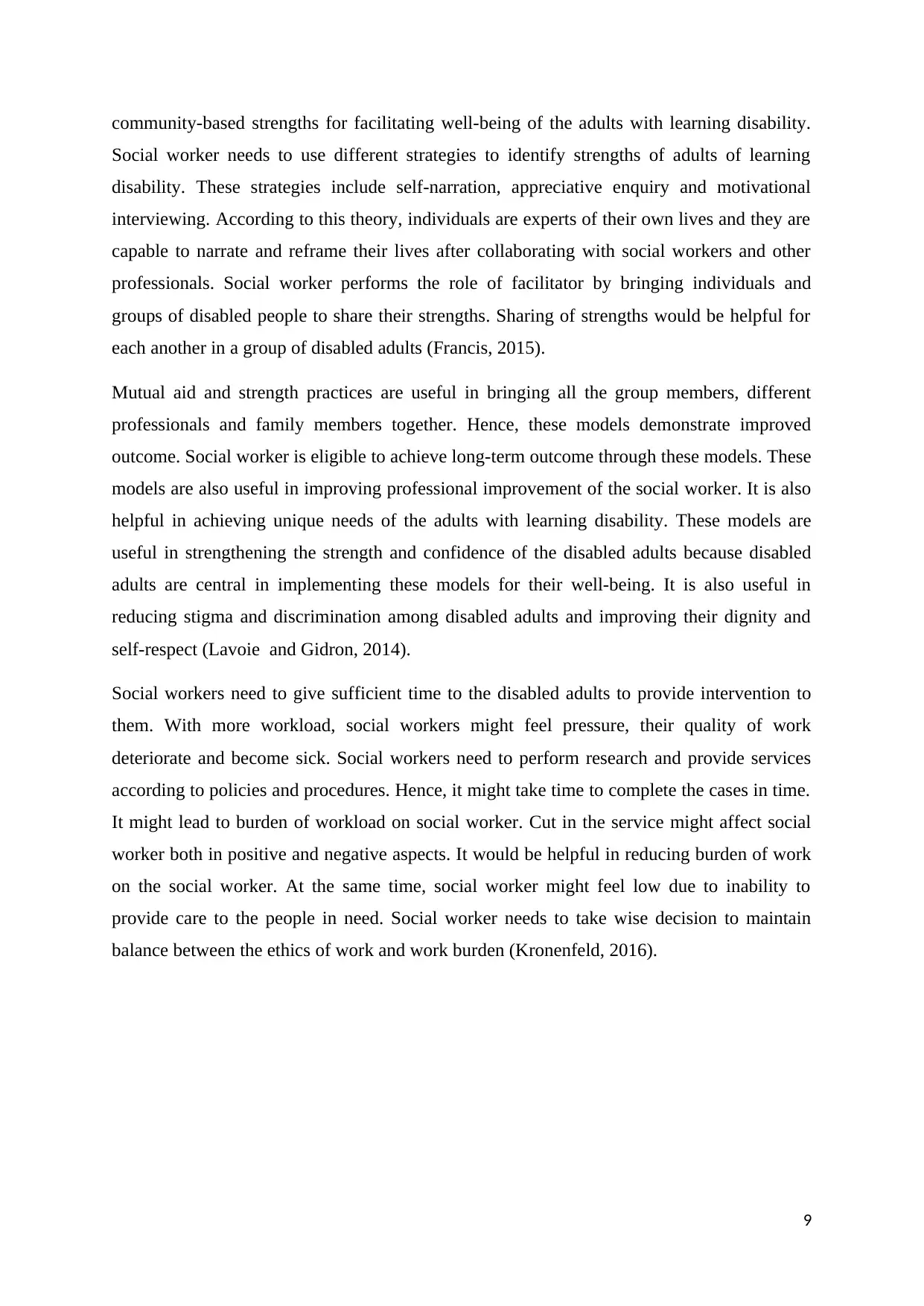
community-based strengths for facilitating well-being of the adults with learning disability.
Social worker needs to use different strategies to identify strengths of adults of learning
disability. These strategies include self-narration, appreciative enquiry and motivational
interviewing. According to this theory, individuals are experts of their own lives and they are
capable to narrate and reframe their lives after collaborating with social workers and other
professionals. Social worker performs the role of facilitator by bringing individuals and
groups of disabled people to share their strengths. Sharing of strengths would be helpful for
each another in a group of disabled adults (Francis, 2015).
Mutual aid and strength practices are useful in bringing all the group members, different
professionals and family members together. Hence, these models demonstrate improved
outcome. Social worker is eligible to achieve long-term outcome through these models. These
models are also useful in improving professional improvement of the social worker. It is also
helpful in achieving unique needs of the adults with learning disability. These models are
useful in strengthening the strength and confidence of the disabled adults because disabled
adults are central in implementing these models for their well-being. It is also useful in
reducing stigma and discrimination among disabled adults and improving their dignity and
self-respect (Lavoie and Gidron, 2014).
Social workers need to give sufficient time to the disabled adults to provide intervention to
them. With more workload, social workers might feel pressure, their quality of work
deteriorate and become sick. Social workers need to perform research and provide services
according to policies and procedures. Hence, it might take time to complete the cases in time.
It might lead to burden of workload on social worker. Cut in the service might affect social
worker both in positive and negative aspects. It would be helpful in reducing burden of work
on the social worker. At the same time, social worker might feel low due to inability to
provide care to the people in need. Social worker needs to take wise decision to maintain
balance between the ethics of work and work burden (Kronenfeld, 2016).
9
Social worker needs to use different strategies to identify strengths of adults of learning
disability. These strategies include self-narration, appreciative enquiry and motivational
interviewing. According to this theory, individuals are experts of their own lives and they are
capable to narrate and reframe their lives after collaborating with social workers and other
professionals. Social worker performs the role of facilitator by bringing individuals and
groups of disabled people to share their strengths. Sharing of strengths would be helpful for
each another in a group of disabled adults (Francis, 2015).
Mutual aid and strength practices are useful in bringing all the group members, different
professionals and family members together. Hence, these models demonstrate improved
outcome. Social worker is eligible to achieve long-term outcome through these models. These
models are also useful in improving professional improvement of the social worker. It is also
helpful in achieving unique needs of the adults with learning disability. These models are
useful in strengthening the strength and confidence of the disabled adults because disabled
adults are central in implementing these models for their well-being. It is also useful in
reducing stigma and discrimination among disabled adults and improving their dignity and
self-respect (Lavoie and Gidron, 2014).
Social workers need to give sufficient time to the disabled adults to provide intervention to
them. With more workload, social workers might feel pressure, their quality of work
deteriorate and become sick. Social workers need to perform research and provide services
according to policies and procedures. Hence, it might take time to complete the cases in time.
It might lead to burden of workload on social worker. Cut in the service might affect social
worker both in positive and negative aspects. It would be helpful in reducing burden of work
on the social worker. At the same time, social worker might feel low due to inability to
provide care to the people in need. Social worker needs to take wise decision to maintain
balance between the ethics of work and work burden (Kronenfeld, 2016).
9
⊘ This is a preview!⊘
Do you want full access?
Subscribe today to unlock all pages.

Trusted by 1+ million students worldwide

References:
Andermann, A. (2016). Taking action on the social determinants of health in clinical
practice: a framework for health professionals. Canadian Medical Association Journal,
188(17-18), pp. E474-E483.
Buck, D. and Frosini, F. (2012) Clustering of unhealthy behaviours over time Implications
for policy and practice. Retrieved from
https://www.kingsfund.org.uk/sites/default/files/field/field_publication_file/clustering-of-
unhealthy-behaviours-over-time-aug-2012.pdf on 11.12.2018.
Burton-Jeangros, C., Cullati, S., Sacker, A., and Blane, D. (2015). A Life Course Perspective
on Health Trajectories and Transitions. Springer. Berlin, Germany.
Butler, M. (2016). Equality and Anti-Discrimination Law: The Equality Act 2010 and other
anti-antidiscrimination protection. Spiramus Press Ltd. Biggleswade. United Kingdom.
Camero, C. (2012). Disability Studies: A Student's Guide. SAGE. Newcastle upon Tyne,
United Kingdom.
Corna, L.M. (2013) A life course perspective on socioeconomic inequalities in health: a
critical review of conceptual frameworks. Advances in Life Course Research. 18(2), pp. 150-
9.
Cooper, C., Lodwick, R., Walters, K., Raine, R., Manthorpe, J., Iliffe, S. and Petersen, I.
(2017) Inequalities in receipt of mental and physical healthcare in people with dementia in
the UK. Age Ageing, 46(3), pp. 393-400.
Cowlishaw, S. and Kessler, D. (2016) Problem Gambling in the UK: Implications for Health,
Psychosocial Adjustment and Health Care Utilization. European Addiction Research, 22(2),
pp. 90-8.
Corrigan, P.W., Morris, S.B., Michaels, P.J., Rafacz, J.D. and Rüsch, N. (2012) Challenging
the public stigma of mental illness: a meta-analysis of outcome studies. Psychiatric Services.
63(10), pp. 963-73.
Dodd, S. (2014). Challenges Facing the Disabled People’s Movement in the UK: An Analysis
of Activist’s Positions. Retrieved from https://core.ac.uk/download/pdf/42137763.pdf on
11.12.2018.
Dominelli, L. and Campling, J. (2002) Anti Oppressive Social Work Theory and Practice.
Macmillan International Higher Education. Basingstoke, United Kingdom.
Evandrou, M., Falkingham, J., Feng, Z. and Vlachantoni, A. (2016) Ethnic inequalities in
limiting health and self-reported health in later life revisited. Journal of Epidemiology and
Community Health. 70(7), pp. 653-62.
Francis, A. P., Pulla, V., Clark, M., Ponnuswami, I. and Mariscal, E. S. (2015). Advancing
Social Work in Mental Health Through Strengths Based Practice. Primrose Hall Publishing
Group. Sydney.
10
Andermann, A. (2016). Taking action on the social determinants of health in clinical
practice: a framework for health professionals. Canadian Medical Association Journal,
188(17-18), pp. E474-E483.
Buck, D. and Frosini, F. (2012) Clustering of unhealthy behaviours over time Implications
for policy and practice. Retrieved from
https://www.kingsfund.org.uk/sites/default/files/field/field_publication_file/clustering-of-
unhealthy-behaviours-over-time-aug-2012.pdf on 11.12.2018.
Burton-Jeangros, C., Cullati, S., Sacker, A., and Blane, D. (2015). A Life Course Perspective
on Health Trajectories and Transitions. Springer. Berlin, Germany.
Butler, M. (2016). Equality and Anti-Discrimination Law: The Equality Act 2010 and other
anti-antidiscrimination protection. Spiramus Press Ltd. Biggleswade. United Kingdom.
Camero, C. (2012). Disability Studies: A Student's Guide. SAGE. Newcastle upon Tyne,
United Kingdom.
Corna, L.M. (2013) A life course perspective on socioeconomic inequalities in health: a
critical review of conceptual frameworks. Advances in Life Course Research. 18(2), pp. 150-
9.
Cooper, C., Lodwick, R., Walters, K., Raine, R., Manthorpe, J., Iliffe, S. and Petersen, I.
(2017) Inequalities in receipt of mental and physical healthcare in people with dementia in
the UK. Age Ageing, 46(3), pp. 393-400.
Cowlishaw, S. and Kessler, D. (2016) Problem Gambling in the UK: Implications for Health,
Psychosocial Adjustment and Health Care Utilization. European Addiction Research, 22(2),
pp. 90-8.
Corrigan, P.W., Morris, S.B., Michaels, P.J., Rafacz, J.D. and Rüsch, N. (2012) Challenging
the public stigma of mental illness: a meta-analysis of outcome studies. Psychiatric Services.
63(10), pp. 963-73.
Dodd, S. (2014). Challenges Facing the Disabled People’s Movement in the UK: An Analysis
of Activist’s Positions. Retrieved from https://core.ac.uk/download/pdf/42137763.pdf on
11.12.2018.
Dominelli, L. and Campling, J. (2002) Anti Oppressive Social Work Theory and Practice.
Macmillan International Higher Education. Basingstoke, United Kingdom.
Evandrou, M., Falkingham, J., Feng, Z. and Vlachantoni, A. (2016) Ethnic inequalities in
limiting health and self-reported health in later life revisited. Journal of Epidemiology and
Community Health. 70(7), pp. 653-62.
Francis, A. P., Pulla, V., Clark, M., Ponnuswami, I. and Mariscal, E. S. (2015). Advancing
Social Work in Mental Health Through Strengths Based Practice. Primrose Hall Publishing
Group. Sydney.
10
Paraphrase This Document
Need a fresh take? Get an instant paraphrase of this document with our AI Paraphraser
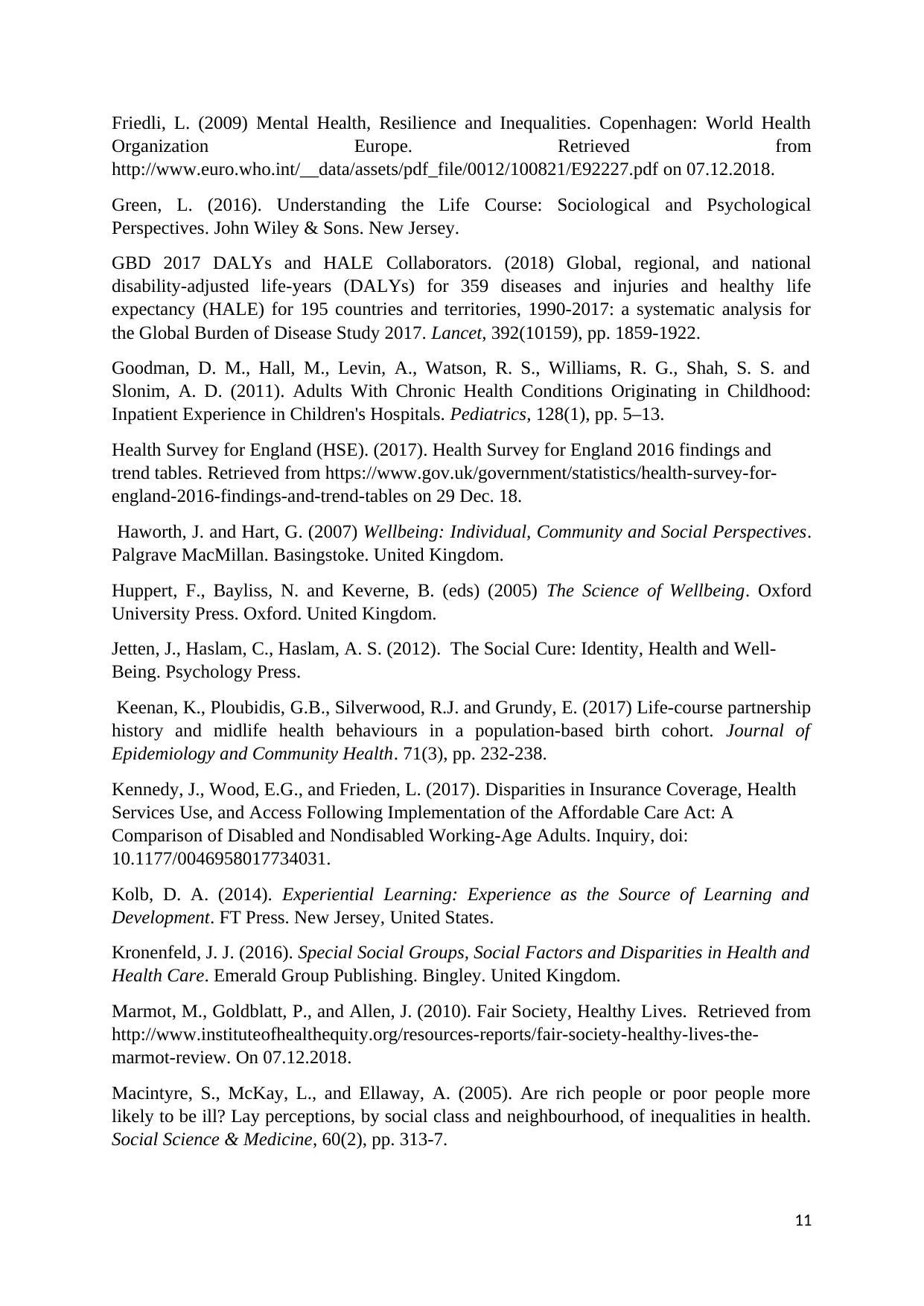
Friedli, L. (2009) Mental Health, Resilience and Inequalities. Copenhagen: World Health
Organization Europe. Retrieved from
http://www.euro.who.int/__data/assets/pdf_file/0012/100821/E92227.pdf on 07.12.2018.
Green, L. (2016). Understanding the Life Course: Sociological and Psychological
Perspectives. John Wiley & Sons. New Jersey.
GBD 2017 DALYs and HALE Collaborators. (2018) Global, regional, and national
disability-adjusted life-years (DALYs) for 359 diseases and injuries and healthy life
expectancy (HALE) for 195 countries and territories, 1990-2017: a systematic analysis for
the Global Burden of Disease Study 2017. Lancet, 392(10159), pp. 1859-1922.
Goodman, D. M., Hall, M., Levin, A., Watson, R. S., Williams, R. G., Shah, S. S. and
Slonim, A. D. (2011). Adults With Chronic Health Conditions Originating in Childhood:
Inpatient Experience in Children's Hospitals. Pediatrics, 128(1), pp. 5–13.
Health Survey for England (HSE). (2017). Health Survey for England 2016 findings and
trend tables. Retrieved from https://www.gov.uk/government/statistics/health-survey-for-
england-2016-findings-and-trend-tables on 29 Dec. 18.
Haworth, J. and Hart, G. (2007) Wellbeing: Individual, Community and Social Perspectives.
Palgrave MacMillan. Basingstoke. United Kingdom.
Huppert, F., Bayliss, N. and Keverne, B. (eds) (2005) The Science of Wellbeing. Oxford
University Press. Oxford. United Kingdom.
Jetten, J., Haslam, C., Haslam, A. S. (2012). The Social Cure: Identity, Health and Well-
Being. Psychology Press.
Keenan, K., Ploubidis, G.B., Silverwood, R.J. and Grundy, E. (2017) Life-course partnership
history and midlife health behaviours in a population-based birth cohort. Journal of
Epidemiology and Community Health. 71(3), pp. 232-238.
Kennedy, J., Wood, E.G., and Frieden, L. (2017). Disparities in Insurance Coverage, Health
Services Use, and Access Following Implementation of the Affordable Care Act: A
Comparison of Disabled and Nondisabled Working-Age Adults. Inquiry, doi:
10.1177/0046958017734031.
Kolb, D. A. (2014). Experiential Learning: Experience as the Source of Learning and
Development. FT Press. New Jersey, United States.
Kronenfeld, J. J. (2016). Special Social Groups, Social Factors and Disparities in Health and
Health Care. Emerald Group Publishing. Bingley. United Kingdom.
Marmot, M., Goldblatt, P., and Allen, J. (2010). Fair Society, Healthy Lives. Retrieved from
http://www.instituteofhealthequity.org/resources-reports/fair-society-healthy-lives-the-
marmot-review. On 07.12.2018.
Macintyre, S., McKay, L., and Ellaway, A. (2005). Are rich people or poor people more
likely to be ill? Lay perceptions, by social class and neighbourhood, of inequalities in health.
Social Science & Medicine, 60(2), pp. 313-7.
11
Organization Europe. Retrieved from
http://www.euro.who.int/__data/assets/pdf_file/0012/100821/E92227.pdf on 07.12.2018.
Green, L. (2016). Understanding the Life Course: Sociological and Psychological
Perspectives. John Wiley & Sons. New Jersey.
GBD 2017 DALYs and HALE Collaborators. (2018) Global, regional, and national
disability-adjusted life-years (DALYs) for 359 diseases and injuries and healthy life
expectancy (HALE) for 195 countries and territories, 1990-2017: a systematic analysis for
the Global Burden of Disease Study 2017. Lancet, 392(10159), pp. 1859-1922.
Goodman, D. M., Hall, M., Levin, A., Watson, R. S., Williams, R. G., Shah, S. S. and
Slonim, A. D. (2011). Adults With Chronic Health Conditions Originating in Childhood:
Inpatient Experience in Children's Hospitals. Pediatrics, 128(1), pp. 5–13.
Health Survey for England (HSE). (2017). Health Survey for England 2016 findings and
trend tables. Retrieved from https://www.gov.uk/government/statistics/health-survey-for-
england-2016-findings-and-trend-tables on 29 Dec. 18.
Haworth, J. and Hart, G. (2007) Wellbeing: Individual, Community and Social Perspectives.
Palgrave MacMillan. Basingstoke. United Kingdom.
Huppert, F., Bayliss, N. and Keverne, B. (eds) (2005) The Science of Wellbeing. Oxford
University Press. Oxford. United Kingdom.
Jetten, J., Haslam, C., Haslam, A. S. (2012). The Social Cure: Identity, Health and Well-
Being. Psychology Press.
Keenan, K., Ploubidis, G.B., Silverwood, R.J. and Grundy, E. (2017) Life-course partnership
history and midlife health behaviours in a population-based birth cohort. Journal of
Epidemiology and Community Health. 71(3), pp. 232-238.
Kennedy, J., Wood, E.G., and Frieden, L. (2017). Disparities in Insurance Coverage, Health
Services Use, and Access Following Implementation of the Affordable Care Act: A
Comparison of Disabled and Nondisabled Working-Age Adults. Inquiry, doi:
10.1177/0046958017734031.
Kolb, D. A. (2014). Experiential Learning: Experience as the Source of Learning and
Development. FT Press. New Jersey, United States.
Kronenfeld, J. J. (2016). Special Social Groups, Social Factors and Disparities in Health and
Health Care. Emerald Group Publishing. Bingley. United Kingdom.
Marmot, M., Goldblatt, P., and Allen, J. (2010). Fair Society, Healthy Lives. Retrieved from
http://www.instituteofhealthequity.org/resources-reports/fair-society-healthy-lives-the-
marmot-review. On 07.12.2018.
Macintyre, S., McKay, L., and Ellaway, A. (2005). Are rich people or poor people more
likely to be ill? Lay perceptions, by social class and neighbourhood, of inequalities in health.
Social Science & Medicine, 60(2), pp. 313-7.
11
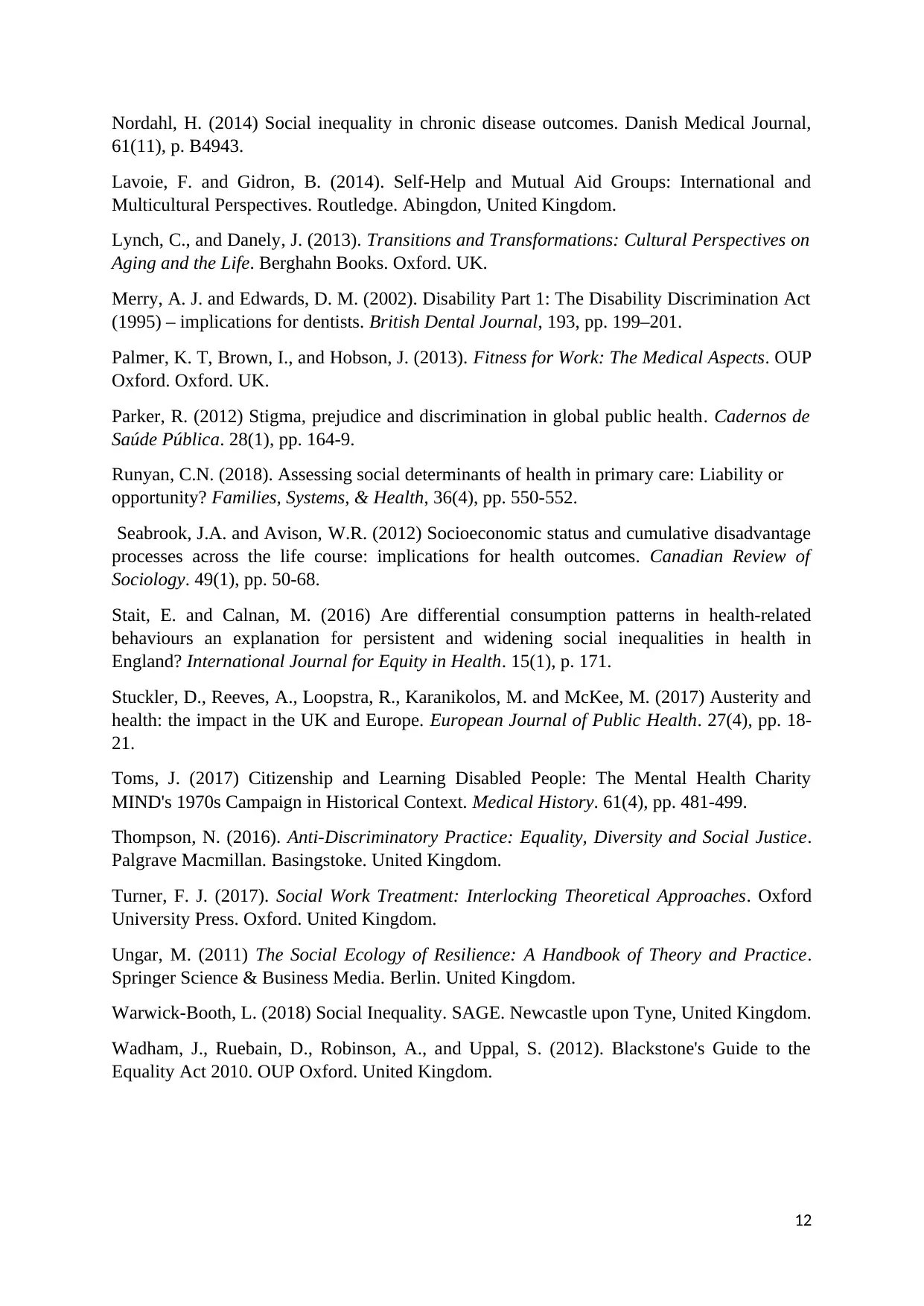
Nordahl, H. (2014) Social inequality in chronic disease outcomes. Danish Medical Journal,
61(11), p. B4943.
Lavoie, F. and Gidron, B. (2014). Self-Help and Mutual Aid Groups: International and
Multicultural Perspectives. Routledge. Abingdon, United Kingdom.
Lynch, C., and Danely, J. (2013). Transitions and Transformations: Cultural Perspectives on
Aging and the Life. Berghahn Books. Oxford. UK.
Merry, A. J. and Edwards, D. M. (2002). Disability Part 1: The Disability Discrimination Act
(1995) – implications for dentists. British Dental Journal, 193, pp. 199–201.
Palmer, K. T, Brown, I., and Hobson, J. (2013). Fitness for Work: The Medical Aspects. OUP
Oxford. Oxford. UK.
Parker, R. (2012) Stigma, prejudice and discrimination in global public health. Cadernos de
Saúde Pública. 28(1), pp. 164-9.
Runyan, C.N. (2018). Assessing social determinants of health in primary care: Liability or
opportunity? Families, Systems, & Health, 36(4), pp. 550-552.
Seabrook, J.A. and Avison, W.R. (2012) Socioeconomic status and cumulative disadvantage
processes across the life course: implications for health outcomes. Canadian Review of
Sociology. 49(1), pp. 50-68.
Stait, E. and Calnan, M. (2016) Are differential consumption patterns in health-related
behaviours an explanation for persistent and widening social inequalities in health in
England? International Journal for Equity in Health. 15(1), p. 171.
Stuckler, D., Reeves, A., Loopstra, R., Karanikolos, M. and McKee, M. (2017) Austerity and
health: the impact in the UK and Europe. European Journal of Public Health. 27(4), pp. 18-
21.
Toms, J. (2017) Citizenship and Learning Disabled People: The Mental Health Charity
MIND's 1970s Campaign in Historical Context. Medical History. 61(4), pp. 481-499.
Thompson, N. (2016). Anti-Discriminatory Practice: Equality, Diversity and Social Justice.
Palgrave Macmillan. Basingstoke. United Kingdom.
Turner, F. J. (2017). Social Work Treatment: Interlocking Theoretical Approaches. Oxford
University Press. Oxford. United Kingdom.
Ungar, M. (2011) The Social Ecology of Resilience: A Handbook of Theory and Practice.
Springer Science & Business Media. Berlin. United Kingdom.
Warwick-Booth, L. (2018) Social Inequality. SAGE. Newcastle upon Tyne, United Kingdom.
Wadham, J., Ruebain, D., Robinson, A., and Uppal, S. (2012). Blackstone's Guide to the
Equality Act 2010. OUP Oxford. United Kingdom.
12
61(11), p. B4943.
Lavoie, F. and Gidron, B. (2014). Self-Help and Mutual Aid Groups: International and
Multicultural Perspectives. Routledge. Abingdon, United Kingdom.
Lynch, C., and Danely, J. (2013). Transitions and Transformations: Cultural Perspectives on
Aging and the Life. Berghahn Books. Oxford. UK.
Merry, A. J. and Edwards, D. M. (2002). Disability Part 1: The Disability Discrimination Act
(1995) – implications for dentists. British Dental Journal, 193, pp. 199–201.
Palmer, K. T, Brown, I., and Hobson, J. (2013). Fitness for Work: The Medical Aspects. OUP
Oxford. Oxford. UK.
Parker, R. (2012) Stigma, prejudice and discrimination in global public health. Cadernos de
Saúde Pública. 28(1), pp. 164-9.
Runyan, C.N. (2018). Assessing social determinants of health in primary care: Liability or
opportunity? Families, Systems, & Health, 36(4), pp. 550-552.
Seabrook, J.A. and Avison, W.R. (2012) Socioeconomic status and cumulative disadvantage
processes across the life course: implications for health outcomes. Canadian Review of
Sociology. 49(1), pp. 50-68.
Stait, E. and Calnan, M. (2016) Are differential consumption patterns in health-related
behaviours an explanation for persistent and widening social inequalities in health in
England? International Journal for Equity in Health. 15(1), p. 171.
Stuckler, D., Reeves, A., Loopstra, R., Karanikolos, M. and McKee, M. (2017) Austerity and
health: the impact in the UK and Europe. European Journal of Public Health. 27(4), pp. 18-
21.
Toms, J. (2017) Citizenship and Learning Disabled People: The Mental Health Charity
MIND's 1970s Campaign in Historical Context. Medical History. 61(4), pp. 481-499.
Thompson, N. (2016). Anti-Discriminatory Practice: Equality, Diversity and Social Justice.
Palgrave Macmillan. Basingstoke. United Kingdom.
Turner, F. J. (2017). Social Work Treatment: Interlocking Theoretical Approaches. Oxford
University Press. Oxford. United Kingdom.
Ungar, M. (2011) The Social Ecology of Resilience: A Handbook of Theory and Practice.
Springer Science & Business Media. Berlin. United Kingdom.
Warwick-Booth, L. (2018) Social Inequality. SAGE. Newcastle upon Tyne, United Kingdom.
Wadham, J., Ruebain, D., Robinson, A., and Uppal, S. (2012). Blackstone's Guide to the
Equality Act 2010. OUP Oxford. United Kingdom.
12
⊘ This is a preview!⊘
Do you want full access?
Subscribe today to unlock all pages.

Trusted by 1+ million students worldwide
1 out of 13
Related Documents
Your All-in-One AI-Powered Toolkit for Academic Success.
+13062052269
info@desklib.com
Available 24*7 on WhatsApp / Email
![[object Object]](/_next/static/media/star-bottom.7253800d.svg)
Unlock your academic potential
Copyright © 2020–2025 A2Z Services. All Rights Reserved. Developed and managed by ZUCOL.





